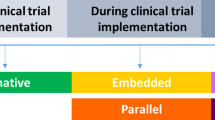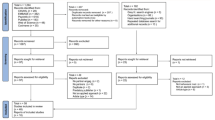Abstract
As the HIV epidemic passes its 35 years mark, the role of multidisciplinary approaches to HIV research has become increasingly important. Development of diverse, cross-cutting research teams has been found to be key to engaging and retaining participants in population-based studies; it is also a crucial component of designing studies capable of examining the sensitive and nuanced issues that surround HIV related risk and adherence behavior. Expanding our understanding of these issues is central to being able to overcome them and ultimately to the development of best practices for translation of research discovery into improvements in prevention and care. The objectives of this paper are to characterize the importance of multidisciplinary teams in HIV research where they are critical to gaining information that can have a positive impact on the epidemic and to propose specific methods for creating teams to conduct research with optimal public health impact.
Similar content being viewed by others
References
Gwadz M, Cleland CM, Leonard NR, Ritchie AS, Banfield A, Riedel M, Colon P, Mildvan D. Predictors of screening for AIDS clinical trials among African-Americans and Latino/Hispanics enrolled in an efficacious peer-driven intervention: uncovering socio-demographic, health, and substance use-related factors that promote or impede screening. AIDS Behav. 2013;17(2):801–12. doi:10.1007/s10461-012-0194-1.
Leonard NR, Banfield A, Riedel M, et al. Description of an efficacious behavioral peer-driven intervention to reduce racial/ethnic disparities in AIDS clinical trials. Health Educ Res. 2013;28(4):574–90. doi:10.1093/her/cyt052.
Ford ME, Siminoff LA, Pickelsimer E, Mainous AG, Smith DW, Diaz VA, Soderstrom LH, Jefferson MS, Tilley BC. Unequal burden of disease, unequal participation in clinical trials: solutions from African American and Latino community members. Health Soc Work. 2013 Feb;38(1):29–38.
Clarke AR, Goddu AP, Nocon RS, Stock NW, Chyr LC, Akuoko JA, Chin MH. Thirty years of disparities intervention research: what are we doing to close racial and ethnic gaps in health care? Med Care. 2013 Nov;51(11):1020–6. doi:10.1097/MLR.0b013e3182a97ba3.
Rodriguez K, Castor D, Mah T, Cook S, Auguiste LM, Halkitis PM, Markowitz M. Participation in research involving novel sampling and study designs to identify acute HIV-1 infection among minority men who have sex with men. AIDS Care. 2013 July;25(7):828–34. doi:10.1080/09540121.2012.748164.
Magnus M, Franks JF, Griffith S, Arnold M, Goodman T, Wheeler DP. Engaging, recruiting, and retaining black men who have sex with men in research studies: don’t underestimate the importance of staffing: lessons learned from HPTN 061, the BROTHERS study. J Public Health Manag Pract. 2014;20(6):1.
Dieffenbach CW, Fauci AS. Thirty years of HIV and AIDS: future challenges and opportunities. Ann Intern Med. 2011;154(11):766–71.
World Health Organization. Global update on the health sector response to HIV. 2014. http://apps.who.int/iris/bitstream/10665/128494/1/9789241507585_eng.pdf?ua=1. Accessed 7 Jan 2015.
United States. Office of national AIDS policy. National HIV/AIDS strategy: federal implementation plan. [Washington, D.C.]: white house office of national AIDS policy; 2010.
Rosenberg ES, Millett GA, Sullivan PS, Del Rio C, Curran JW. Understanding the HIV disparities between black and white men who have sex with men in the USA using the HIV care continuum: a modeling study. Lancet HIV. 2014;1(3):e112–8.
Muchomba FM, Gearing RE, Simoni JM, et al. State of the science of adherence in pre-exposure prophylaxis and microbicide trials. J Acquir Immune Defic Syndr. 2012;61(4):490–8. doi:10.1097/QAI.0b013e31826f9962.
Amico RK, Stirratt MJ. adherence to preexposure prophylaxis: current, emerging, and anticipated bases of evidence. Clin Infect Dis. 2014;59(1):S55–60. doi:10.1093/cid/ciu266.
Van Damme L, Corneli A, Ahmed K, Agot K, Lombaard J, Kapiga S, Malahleha M, Owino F, Manongi R, Onyango J, Temu L, Monedi MC, Mak’Oketch P, Makanda M, Reblin I, Makatu SE, Saylor L, Kiernan H, Kirkendale S, Wong C, Grant R, Kashuba A, et al. Preexposure prophylaxis for HIV infection among African women. N Engl J Med. 2012;367(5):411–22. doi:10.1056/NEJMoa1202614.
United States Public Health Service. Preexposure prophylaxis for the prevention of HIV infection in the United States-2014: a clinical practice guideline. Atlanta: Centers for disease control and prevention; 2014.
World Health Organization. Guidance on oral pre-exposure prophylaxis (PrEP) for serodiscordant couples, men and transgender women who have sex with men at high risk of HIV: recommendations for use in the context of demonstration projects. 2012. http://apps.who.int/iris/bitstream/10665/75188/1/9789241503884_eng.pdf?ua=1.
Choi BC, Pak AW. Multidisciplinarity, interdisciplinarity and transdisciplinarity in health research, services, education and policy: 1. definitions, objectives, and evidence of effectiveness. Clin Invest Med. 2006;29(6):351–64.
Choi BC, Pak AW. Multidisciplinarity, interdisciplinarity, and transdisciplinarity in health research, services, education and policy: 2. promotors, barriers, and strategies of enhancement. Clin Invest Med. 2007;30(6):224–32.
Tillman RE, Jang S, Abedin Z, Richards BF, Spaeth-Rublee B, Pincus HA. Policies, activities, and structures supporting research mentoring: a national survey of academic health centers with clinical and translational science awards. Acad Med. 2013 Jan;88(1):90–6. doi:10.1097/ACM.0b013e3182772b94.
Ameredes BT, Hellmich MR, Cestone CM, Wooten KC, Ottenbacher KJ, Chonmaitree T, Anderson KE, Brasier AR. The multidisciplinary translational team (MTT) model for training and development of translational research investigators. Clin Transl Sci. 2015;8(5):533–41. doi:10.1111/cts.12281.
Romera-Daza N, Baldwin JA, Lescano C, Williamson HJ, Tilley DL, Chan I, Tewell M, Palacio WR. Syndemic theory as a model for training and mentorship to address HIV/AIDS among Latinos in the United States. Ann Anthropol Pract Vol. November 2012;36(2):232–56. doi:10.1111/napa.12002.
(21) National Institutes of health, Centers for AIDS research program information. http://www.niaid.nih.gov/labsandresources/resources/cfar/Pages/default.aspx.
Blank MB, Metzger DS, Wingood GM, DiClemente RJ. The social and behavioral sciences research network: translational research to reduce disparities in HIV. J Acquir Immune Defic Syndr. 2013 Jun;1(63 Suppl 1):S1–3. doi:10.1097/QAI.0b013e3182921554.
National Institutes of health HIV prevention trials network scholars program http://www.hptn.org/hptn_structure/scholars.htm.
Greenberg AE, Purcell DW, Gordon CM, Flores S, Grossman C, Fisher HH, Barasky RJ. NIH support of Centers for AIDS research and department of health collaborative public Health research: advancing CDC’s enhanced comprehensive HIV prevention planning project. J Acquir Immune Defic Syndr. 2013 Nov;1(64 Suppl 1):S1–6. doi:10.1097/QAI.0b013e3182a99bc1.
Greenberg AE, Purcell DW, Gordon CM, Barasky RJ, del Rio C. Addressing the challenges of the HIV continuum of care in high-prevalence cities in the United States. J Acquir Immune Defic Syndr. 2015;69(1):S1–7. doi:10.1097/QAI.0000000000000569.
Beech BM, Calles-Escandon J, Hairston KG, Langdon SE, Latham-Sadler BA, Bell RA. Mentoring programs for underrepresented minority faculty in academic medical centers: a systematic review of the literature. Acad Med. 2013 Apr;88(4):541–9. doi:10.1097/ACM.0b013e31828589e3.
Gandhi M, Fernandez A, Stoff DM, Narahari S, Blank M, Fuchs J, Evans CH, Kahn JS, Johnson MO. Development and implementation of a workshop to enhance the effectiveness of mentors working with diverse mentees in HIV research. AIDS Res Hum Retrovir. 2014;30(8):730–7. doi:10.1089/AID.2014.0018.
Johnson MO, Gandhi M. A mentor training program improves mentoring competency for researchers working with early-career investigators from underrepresented backgrounds. Adv Health Sci Educ Theory Pract. 2014;20(3):683–9.
Developing the HIV workforce. a case study of a training model for inexperienced HIV providers. J Health Care Poor Underserved. 2012 Nov;23(4):1502–11. doi:10.1353/hpu.2012.0152.
Nash JM. Transdisciplinary training: key components and prerequisites for success. Am J Prev Med. 2008;35(2):S133–40. doi:10.1016/j.amepre.2008.05.004.
McGee R Jr, Saran S, Krulwich TA. Diversity in the biomedical research workforce: developing talent. Mt Sinai J Med. 2012;79(3):397–411. doi:10.1002/msj.21310.
Morrison E, Grbic D. Dimensions of diversity and perception of having learned from individuals from different backgrounds: the particular importance of racial diversity. Acad Med. 2015;90(7):937–45.
Rodriguez JE, Campbell KM, Fogarty JP, Williams RL. Underrepresented minority faculty in academic medicine: a systematic review of URM faculty development. Fam Med. 2014 Feb;46(2):100–4.
Sopher CJ, Adamson BJ, Andrasik MP, Flood DM, Wakefield SF, Stoff DM, Cook RS, Kublin JG, Fuchs JD. Enhancing diversity in the public health research workforce: the research and mentorship program for future HIV vaccine scientists. Am J Public Health. 2015;105(4):823–30. doi:10.2105/AJPH.2014.302076.
Tabak LA, Collins FS. Weaving a richer tapestry in biomedical science. Science. 2011;333(6045):940–1. doi:10.1126/science.1211704.
Turner CSV, Gonzales JC. Faculty of color in academe: what 20 years of literature tells us. J Divers High Educ. 2008;1(3):139–68. doi:10.1037/a0012837.
Centers for disease control and prevention national hiv behavioral surveillance (NHBS). http://www.cdc.gov/hiv/statistics/systems/nhbs/.
HIV prevention trials network (HPTN) http://www.hptn.org.
Institute of Medicine. In the nation’s compelling interest: ensuring diversity in the health care workforce. 2004. https://iom.nationalacademies.org/Reports/2004/In-the-Nations-Compelling-Interest-Ensuring-Diversity-in-the-Health-Care-Workforce.aspx. Accessed 15 March 2016.
Sutton MY, Lanier YA, Willis LA, Castellanos T, Dominguez K, Fitzpatrick L, Miller KS. Strengthening the network of mentored, underrepresented minority scientists and leaders to reduce HIV-related disparities. AJPH. 2013;103:2207–14.
Fuchs J, Kouyate A, Kroboth L, McFarland W. Growing the pipeline of diverse HIV investigators: the impact of mentored research experiences to engage underrepresented minority students. AIDS Behav. 2016;11:1–9.
Acknowledgments
Authors received guidance from the District of Columbia Center for AIDS Research (DC CFAR), a NIH-funded program (P30AI087714). The Authors are grateful to Dr. Victoria Cargill and Dr. David Stoff for including them in the conference that stimulated this work. They also gratefully acknowledge the collaboration of many research teams with whom they have worked over the years.
Author information
Authors and Affiliations
Corresponding author
Rights and permissions
About this article
Cite this article
Magnus, M., Castel, A. Breaking Down the Siloes: Developing Effective Multidisciplinary HIV Research Teams. AIDS Behav 20 (Suppl 2), 273–280 (2016). https://doi.org/10.1007/s10461-016-1487-6
Published:
Issue Date:
DOI: https://doi.org/10.1007/s10461-016-1487-6




